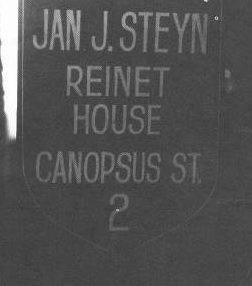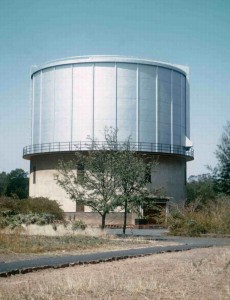Noted for:
- “During it’s quarter-century of active life, the Radcliffe Observatory accomplished more than many other observatories have done in hundreds of years.” [Copied from Moore, p.119.]
Summary:
- Researched radial velocities of Stars.
- Radcliffe Observatory is the Astronomical Observatory for Oxford University (U.K.). Due to bad seeing conditions in England, it was decided in the 1920s to set up an observatory in the Southern Hemisphere. The site chosen was located just outside of Pretoria.
- An observatory was built and a telescope ordered just before World War Two. The war delayed construction, to the extent that the telescope was ordered in 1935, but saw first light in 1948.
- Radcliffe Observatory was a well-designed facility, manned by competent astronomers, operating the largest telescope at that time in South Africa.
- Light pollution is an International problem, and in the 1960’s three of South Africa’s Observatories were badly affected by light pollution. They were the Cape Observatory (Cape Town), Radcliffe Observatory (Pretoria) and Republic Observatory (Johannesburg). By an agreement between the South African CSIR and the British Science Research Council (23 September 1970), a new facility was created away from light pollution at Sutherland in the Karoo. The main instruments from the Cape and Republic Observatories were moved to the new sight, and the Cape Observatory grounds became the headquarters for the new South African Observatories (today the South African Astronomical Observatory S.A.A.O.)
- Radcliffe Observatory closed down, and its 74-inch telescope was bought and moved to Sutherland.
Thus the original Radcliffe Observatory ceased to exist and was incorporated into a new entity, the S.A.A.O., which for reasons of convenience and space will be dealt with in this website as a separate establishment.
|
History:
- “The observatory at Oxford was founded in 1772 by the Radcliffe Trustees, and was therefore always known as the Radcliffe Observatory. Telescopes were set up, and were extensively used; but nothing can be done about the British climate, and so far as optical viewing is concerned there are serious limitations. Moreover, even in the early 1900s Oxford was spreading; from being a university with a small town tacked on, it was turning rapidly into an industrial city, with all the benefits of urban civilisation – such as smoke, grime, fumes and smog. Clearly it was desirable to move elsewhere, and the man who seems to have provided the first impetus was the then Radcliffe Observer, Harold Knox-Shaw, who had taken up his Oxford duties on 18 August 1924″. [Copied from Moore, p.114.]
- “Knox-Shaw, used to the clear Egyptian skies, was not in the least impressed by observational conditions at Oxford and he soon began laying plans for a move. He had the support of Sir Frank Dyson, the Astronomer Royal and the change soon came. In 1929 the Radcliffe Infirmary felt the need for expansion and offered to buy the nine-acre site on which the Observatory had operated for the previous hundred and fifty years. By then Knox-Shaw and Dyson had already made a preliminary reconnaissance to South Africa and on their return it was tacitly agreed that the shift should be made. In November 1929 an agreement of sale to the Medical School was announced.” [Copied from Moore, p.114.]
- “It only remained to find a suitable location in South Africa. Pretoria had a good climate and was convenient in many other ways as well, but it was essential to be quite sure. The Trustees decided that the man to find out was Dr W. H. Steavenson, … Steavenson came to Pretoria and carried out an extensive series of tests from a hilltop to the Southeast of the city. Steavenson’s report was favourable. The Municipal authorities then stepped in and offered to make the Radcliffe Trust a gift of the 57-acre site; they even promised to lie on water and electricity. It was a generous offer; the Pretoria authorities kept their word and continued to give all possible help throughout the Observatory’s career.” [Copied from Moore, pp.114 – 115.]
- “Unfortunately, an Oxford faction led (typically!) by Professor F. A. Lindemann, afterwards Lord Cherwell, caused prolonged delays by opposing the transfer of Trust capital to an area outside the jurisdiction of the English courts. Among those who were called in to support the move were Knox-Shaw, Dyson, Sir Arthur Eddington, Schlesinger, Shapley, de Sitter and Spencer Jones. Eventually, in July 1934, the battle was won.” [Copied from Moore, p.115.]
- The site chosen for the Observatory was approximately five miles (8 km) to the South East of the city, on a range of hills at an altitude of approximately 5 000-ft (1 500 m) above sea level.
- The Observatory buildings with the dome, was built and in 1939 the astronomers moved in. The director was Knox-Shaw, with R.O. Redman as chief assistant and E. Gwyn Williams as second assistant. There was however no telescope.
- In August 1935 the order for the telescope was placed with Grubb Parsons. The telescope was 74-inch (1.8 m) in diameter, and for half a century the largest telescope in South Africa. Due to the size of the telescope a successful mirror was only cast on the third attempt in 1938. Thereafter World War Two completely interrupted the building of the telescope. The telescope was installed in 1948, 13 years after it was ordered.
- The Radcliffe Observatory had insufficient funds to maintain a sufficient staff. By the time the telescope was installed, the Observatory staff has been reduced. Knox-Shaw was still director, but Redman and Williams left and replaced by a single person, David Evans (1946 – 1951) as assistant. There were also three unskilled labourers. [Smits: Evans Obituary – MNASSA, p.6]
- In 1948 A.D. Thackeray was appointed as Chief Assistant. [Evans Obituary – MNASSA, p.6] He took over the post of Director in 1951 from Knox-Shaw. It was during his time that the Observatory enjoyed its most productive years.
- Evans made many useful contributions to the observatory. He modified the telescope to safely house the primary which came out thinner than accepted. An aluminising plant was constructed capable of coating mirrors up to 15-inches (38 cm) in diameter. Evans also designed and built a Newtonian spectrograph for the telescope. [Evans Obituary – MNASSA, pp.6 – 7]
- Due to the insufficient funds Radcliffe Observatory leased about half of their observing time to the Cape Observatory. David Evans, assistant to Knox-Shaw, accepted the post of chief assistant at Cape Observatory in 1951, but because of the lease arrangement spent a lot of time at the Radcliffe Observatory. [Smits: Evans Obituary – MNASSA, p.6] Thus Evans never really left the premises although he was now working for someone else.
- Radcliffe became a very well known and established Astronomical Institution. The Observatory attracted many excellent visiting astronomers from all over and became a very popular place for students to finish their doctoral studies. Many observers came to Radcliffe to do specialised research. [Moore, pp.118 – 119.]
- In the vicinity of the Observatory a suburb developed “…and, appropriately, many of the roads were re-named according to a cosmical pattern: Orion Street, Perseus Street and so on. One of these new names gave rise to an episode, which still tends to make astronomer’s chuckle. The second brightest star in the entire sky is Canopus, in the constellation of Carina, the Keel of the old Ship Argo. Naturally, it had to have a road named after it, but the local authorities accidentally inserted an extra S, and up went the official sign: Canopsus Street. Canopsus Street it remained, but after many years a distinguished astronomer, then resident in Pretoria, wrote to the authorities and pointed out the error. The reply was stunning. “The name Canopsus is on all our maps, and has been officially accepted,” they wrote. “It cannot be altered now. Can’t you change the name of the star?” It is not very likely that such an idea appealed to members of the International Astronomical Union. …the road has now been renamed Canopus, . . .” [Copied from Moore, pp.115 – 116.]
|
Pictorial Sources:
Moore, P. & Collins, P., Astronomy in Southern Africa, p.117; p.118.
Bibliography:
- Smits, P., A Brief History of Astronomy in Southern Africa. (Unpublished)
- Moore, P. & Collins, P., Astronomy in Southern Africa, pp114 – 119. (General Source)
- Evans Obituary: MNASSA Vol. 64, Nos 1 & 2, February 2005.
|

 The offices and library of the Radcliffe Observatory with the dome of the 74 inch telescope in the background.
The offices and library of the Radcliffe Observatory with the dome of the 74 inch telescope in the background.

